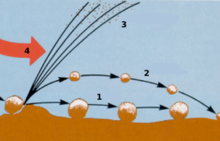Saltation
Saltation refers to the sudden transport of grains of sand with a grain size of 70–500 µm or 70–100 µm (modified saltation) . In addition, the term describes both the fine-clastic sediment material on the bottom of a river bed and the aeolian formation of dunes on land.
When a grain of sand hits the ground, energy is transferred to the surrounding grains of sand, causing them to jump up and follow a parabolic trajectory ( reptation ). This trajectory results from the wind direction and gravity . The transport speed depends on the surface. On rough ground, the transport slows down due to friction losses. As a result, small accumulations of sand grow in self-reinforcement to form dunes.
The grains of sand are deposited in the lee of obstacles such as a dune during their transport . This leads to a dune migration .
Only through the impact of salting grains can even finer particles be released from the soil composite. These are transported in short-term suspension (particles with a diameter of 20–70 µm) over several kilometers. Even smaller particles (<20 µm in diameter) can travel enormous distances as fine dust in the atmosphere (long-term suspension) . In dust storms they lead to ecological, economic and health impairments.
